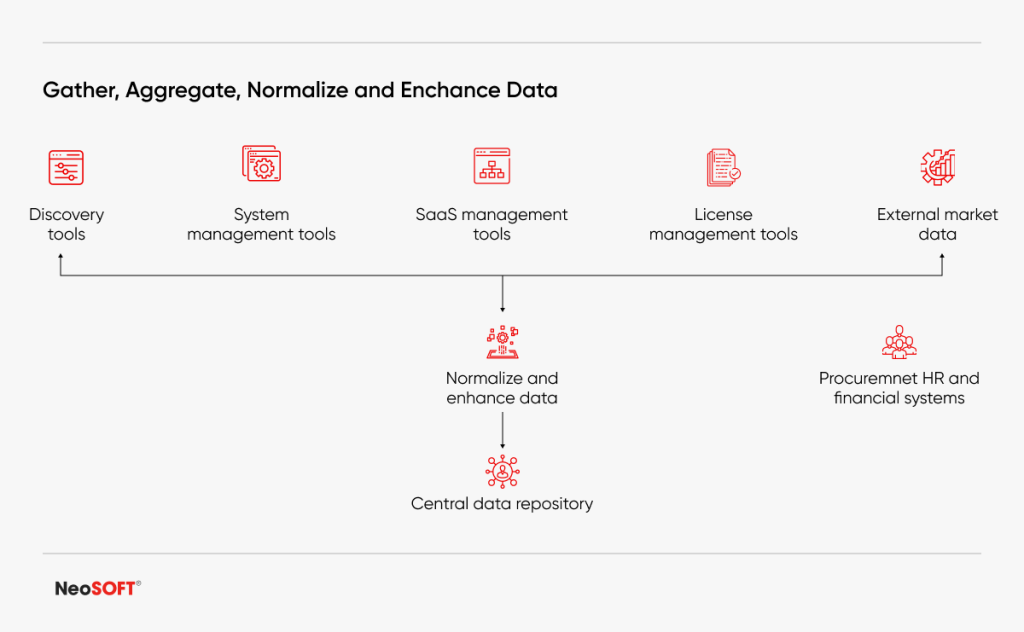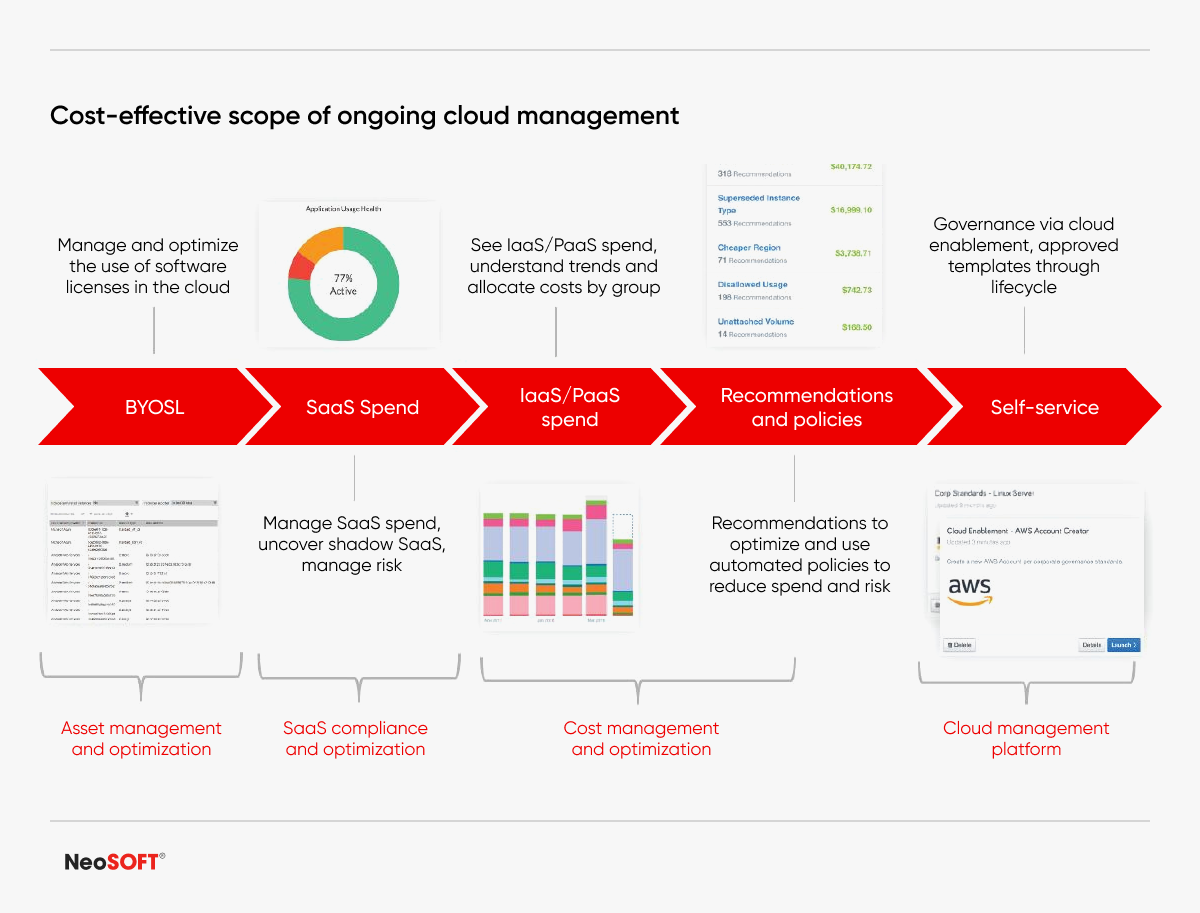Embarking On A Successful Cloud Journey
April 7, 2023
Successful Cloud transformation embraces new ideas and deploys flexible technology for data analysis, collaboration, and customer focus. Digital transformation with the Cloud is essential to keep pace with the changing business and market dynamics. Cloud technology is now a part of the playbook for most enterprise IT departments, with Cloud enabling digital transformation by creating and modifying business processes, culture, and customer experience. Cloud adoption can be challenging for businesses without the right strategy. Unaligned efforts often fall flat for most organizations due to a lack of planning and a poor understanding of business objectives.
Starting Your Cloud Journey The Right Way – Steps To Cloud Transformation
A cloud journey enables companies to seamlessly move their applications and workloads to the Cloud. A strategic approach that avoids disrupting current processes is the right path to a successful Cloud journey and transformation. Here are a few essential steps that will guide you in your cloud journey:
1. Adopt A Three-Pillar Approach.
Business, operations, and technology are the three core pillars of any company. A strategic approach that addresses these three pillars is integral to getting maximum value from cloud adoption or migration. Identifying business domains that can realize the full potential of the Cloud to increase revenues and improve margins, choosing technologies in line with your business strategy and risk constraints, and implementing operating models oriented around the Cloud will enable companies to drive innovation and achieve sustainable, long term success with cloud transformation.
2. Prioritize These Questions Before Crafting Your Cloud Transformation Strategy.
Before you embrace a cloud journey, answering these questions will help clarify your security strategy and establish a roadmap for your cloud journey. Here are a few essential questions you need to answer:
⦁ What is your motivation to invest in Cloud?
⦁ What challenges will the cloud address?
⦁ Will customers derive tangible benefits from switching to the Cloud?
⦁ What long-term benefits are you looking to achieve?
⦁ How will the cloud impact business and organization culture?
⦁ How will cloud transformation impact current business processes?
⦁ In what ways have you integrated technology throughout your company? What are your expectations?
⦁ Do you have an existing strategy for successful cloud adoption and migration?
3. Navigate The Cloud, One Step At A Time.
Cloud transformation can be complex, but following certain best practices can ensure a successful journey. Dividing the cloud migration process into planning, migration, and ongoing cloud management will help achieve integrated transformation. Let us look at each of these steps in detail.
Planning
The planning process consists of three main steps: Discovery, Assessment, and Prioritization. Discovery refers to identifying all the assets in your technology landscape. Assessment includes evaluating the suitability of on-premises apps and services for migration. The prioritization process determines which applications and services should be migrated to the Cloud to establish a timeline. Let’s look at the three steps: discovery, assessment, and prioritization.
1. Discovery
A thorough understanding of the on-premises environment is crucial before migrating to the Cloud. Many businesses still rely on traditional IT architectures, with applications designed for on-premises use. An accurate overview of all the on-premises applications is essential for effective migration planning. The IT landscape’s hardware, software, relationships, dependencies, and service maps need careful evaluation during discovery—any potentially hidden SaaS apps considered to ensure a clear understanding of the technology landscape.
Track assets to delve deeper into more critical details about them:
⦁ Ownership details
⦁ Asset usage patterns
⦁ The cost incurred for the assets
⦁ End-of-life or end-of-service dates
⦁ Software licensing terms, conditions, and renewals
⦁ Application compatibilities
⦁ Security vulnerabilities
As illustrated in the figure below, most of this information is available in your company’s internal sources, such as system & license management tools, procurement systems, human resources systems, and internal sources. At the same time, you can obtain information about EOL and EOS dates, compatibility issues, and security vulnerabilities from external sources. Such information contains clues that allow organizations to plan their cloud migration journey effectively.
The next step is to assess which apps and services need migration to the Cloud. The key factors to consider when determining the suitability of existing applications and cloud providers for migration are as follows:
2. Assessment
The next step is to assess which apps and services need migration to the Cloud. The key factors to consider when determining the suitability of existing applications and cloud providers for migration are as follows:
⦁ The level of effort needed to migrate an app or service.
⦁ Apps and services that don’t require migration.
⦁ Architecture or security concerns and business impact or customer impact.
⦁ The total cost of ownership of on-premises apps or services.
It is essential to determine which applications fit better into the Cloud environment. When migrating apps and services to the Cloud, key decision-makers need to be sure of the benefits it will bring in the long term. Companies must evaluate the cost of running the apps on the Cloud compared to keeping them on-premises with assessment tools.
3. Prioritization
This phase prioritizes the apps that must move to the Cloud first. How do you determine which apps must migrate first and which can wait? Let’s prioritize.
⦁ Start your migration process by focusing on less complex apps.
⦁ Choose apps that will have a low impact on the business operations.
⦁ Give priority to internal-facing applications before the customer-facing application.
Businesses can opt for migration for technological reasons. Migrating an app with heavy storage requirements makes sense only if its storage usage is near capacity and demands hardware upgrades on-premises.
Cloud Migration
Consider the changes migration will bring to your business model. Before migrating the assets, they should share the data acquired in the planning and assessment stage with the stakeholders and IT teams. Hence, everyone is well aware of migration’s impact on the business. Here are a few steps outlined to maximize the chances of successful cloud migration.
1. Plan your Cloud migration.
Consider the total cost and migration structure and evaluate the service provider for your migration beforehand. Establish the migration architect role to design strategies for data migration and define cloud-solution requirements. A migration architect plays a critical role in executing all aspects of the migration. Determine the level of cloud integration (shallow cloud integration or deep cloud integration). Choose whether to go single-cloud or multi-cloud, depending on your business requirements. Establish performance baselines well in advance to diagnose any problems and evaluate post-migration performance.
2. Prioritize Cloud Infrastructure security.
Security is a significant concern for every business when switching to Cloud. An impactful analysis is integral to understanding the security gaps in the cloud transformation journey. Companies increasingly rely on machine data to gain insights into security vulnerabilities and ensure apps and services run securely. Picking the right cloud hosting platform is crucial to ensure the longevity, stability, speed, security, and cost-efficiency of the digital assets you have planned for cloud enablement.
3. Set objectives and key results.
Before starting the migration process, businesses must establish objectives and key results (OKRs). Objectives and key results help determine whether the migration has benefited the organization. Development productivity, user and developer experience, stability and security, and speed to market/delivery are a few of the critical metrics businesses must measure to ensure a successful migration.
4. Set up compliance baselines.
Businesses need to adhere to a set of rules and regulations when planning their migration. Compliance rules keep evolving in response to the threat landscape, and companies should ensure continued compliance by investing in the proper security controls and configurations.
You can put your cloud migration plan in motion for one or more assets after evaluating factors such as urgency, adaptability, and ease of execution. Businesses often consider metrics such as the total number of users, device count, location, interoperability, business continuity, and data integrity.
Tips for Successful Cloud Migration
Listed below are a few tips businesses can follow to ensure a future smooth migration:
A cloud strategy should align with your business strategy and business operations.
Creating a cloud strategy that aligns differently from your overall business strategy could benefit your ROI. Your cloud migration strategies should support and facilitate the implementation of business strategies. Focus on more than just the IT aspect of your business. Ensure the chosen business verticals benefit from your cloud strategy.
Assess Cloud-related risks.
Businesses must assess the five cloud-related risks such as agility risk, availability risk, compliance risk, security risk, and supplier risk. Evaluating these risks ensures sound cloud deployment decisions for your business. Weighing the risks against the benefits offers better clarity on the post-migration performance of the company.
Consider different Cloud migration strategies.
There are different approaches to cloud migration, and you can select the one that best suits your needs. Rehost, refactor, repurchase, re-platform, retain, and remove are the six cloud migration strategies businesses can implement.
Get rid of data silos.
Data silos present multiple risks and impede performance. Businesses should establish a common data platform across clouds to eliminate silos. A unified view of the Cloud with a single platform ensures a seamless user experience while eliminating the need to refactor for separate vendors when moving data from one Cloud to another.
Utilize Cloud staging.
Cloud staging refers to moving elements of end-user computing to the Cloud. It helps users transform desktops with centralized cloud-based storage. Businesses choose between maintaining existing desktop types alongside a new platform or migrating their users entirely to the new platform. With cloud staging, users can migrate to another desktop with zero downtime for maximum productivity.
Create a Cloud-first environment
Creating a cloud-first environment will ensure your business reaps the full benefits of cloud adoption. To adapt to the cloud environment workforce must be trained. The Cloud is a powerful tool for digital transformation and an inseparable component driving innovation for your business. By utilizing the Cloud’s scalability, flexibility, and advanced features, companies are successfully transforming their operations, optimizing their resources, and unlocking new growth opportunities.
Execute effective testing
Testing gives insights into whether the migration will produce the desired results. Testing enables you to simulate real-world workloads to understand slowdowns and outages as you migrate across load scales.
Ongoing Cloud Management
Ongoing cloud management refers to managing the applications and services on the Cloud as soon as the migration is complete. Cloud migration is not a one-off activity. After migration, businesses must operate and optimize in response to changing business requirements.
Cloud management begins with the migration of the first workload. Automation tools play a critical role in managing cloud-based workloads. Cloud management is essential to ensure optimal resource management, security, and compliance in this fast-paced environment.
An overview of the cost-effective scope of ongoing support for cloud management consulting might help understand its need better.
We list below the top cloud challenges and tips to curb them in your ongoing cloud management activity:
1. Cloud governance and compliance
Governance is crucial in maintaining the alignment between technology and business and ensuring compliance with corporate policies, industry standards, and government regulations.
⦁ Set standardized architectures that comply with corporate versions, patches, and configuration guidelines.
⦁ Capitalize on reusable templates to deploy standardized architectures and orchestrate infrastructure and services across public clouds.
⦁ Orchestrate ongoing operations such as monitoring and performance optimization; alerts, notifications, and escalations; and self-healing capabilities.
⦁ Automate compliance with governance frameworks
When individuals and departments acquire SaaS apps without the knowledge of Central IT, such apps may not comply with the rules and regulations as they are outside the purview of the IT governance framework. Therefore, central IT must be involved in technology selection to align the assets with the compliance requirements. Implementing the right governance tools will enable companies to automate compliance and define standardized architectures that comply with corporate guidelines.
2. Optimizing spends
Optimizing cloud spending is a significant challenge facing modern businesses. Cloud resources used optimally achieve more substantial cost savings. Ongoing cloud management ensures the efficient use of cloud resources at reduced costs. Best practices include:
⦁ Eliminating apps with overlapping functionality.
⦁ Identifying unused apps.
⦁ Implementing the latest tools to identify areas with potential for cost savings.
⦁ Leveraging cloud-based automation to increase productivity.
3. Strengthening security
Decentralized decision-making is a significant contributor to weak security. All stakeholders and employees involved should be equally aware of the importance of safety and the best practices to ensure maximum Cloud security. There are different tools that businesses can employ to improve security in the cloud environment. These tools will send alerts for misconfigured networking, facilitate role-based access, maintain audit trails that track cloud resource usage, and ensure integration with SSO and directory services for consistent access to cloud resources.
NeoSOFT has been fueling the shift towards cloud enablement for businesses across industries.
Developed AWS Cloud Infrastructure and Containerized Applications
NeoSOFT provided a cloud architecture solution design and VPN tunneling for authorized access to sensitive data. This mechanism adds an extra security layer to the stored data. Our developers utilized an OS-level virtualization method for application containerization to deploy and run distributed application solutions.
Impact: 70% Increase in Data Efficiency
Integrated IoT and Cloud Computing for a Customized Home Automation System
Our team of expert cloud engineers leveraged automation and cloud tools to develop a cross-platform application that integrated a simple and intuitive design, offering seamless access to smart home devices. The application’s user-friendly interface boosted engagement by providing greater control over security, energy efficiency, and low operating costs. Enable users to monitor, schedule, and automate all their smart devices from one location.
Impact: 25% Increase in Download Speeds
Engineered a Robust Cloud-Based Web App for the World’s First Fully-Integrated Sports Smart-Wear Company.
Our Cloud engineers empowered the client with cloud computing and data management tools to construct a website featuring distinct modules for the admin, affiliate marketing, and channel partners. The app efficiently manages country-specific distribution, influencer-based product promotion, and user data access. Advanced analytics integration also provided real-time sales reports, inventory management, device tracking, and production glitch reporting.
Impact: 30% Increase in Operational Excellence
The Road to Cloud Success
Navigating the journey and transition toward cloud transformation can be challenging. However, many enterprises have moved to the Cloud in response to challenges they have experienced, like unexpected outages, downtime, data loss, lack of flexibility, complexity, and increased costs. Businesses that embrace cloud transformation may retain their competitive advantage. Cloud migration allows enterprises to move from a Cap-Ex-based IT infrastructure to an Op-Ex-based model.
The right people, processes, and tools can facilitate a smooth cloud transformation journey. Businesses can witness sustained results only if technology execution capabilities are up to the task. The key to cloud transformation success is to select a migration model that aligns with economic and risk constraints. The company should clearly understand its risk appetite and business strategies when making cloud transformation decisions and evaluating its IT capabilities.




















